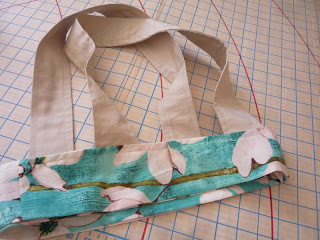You will need:
- a machine that has a blind hem setting (almost all of them do)
- a blind hem presser foot
- something to hem, such as a dress, skirt, or curtains (or pants, but those are a little difficult to do on the machine and I would probably just hem them by hand)
Start off just like normal - finish everything except the hem and determine your finished length. As with a handsewn hem, trim to the desired length plus about 1.5" on the bottom for the hem. Now fold the raw edge up about .5" and press. Fold it again, this time about 1" and press, then pin in place. Same as usual, right?
To prepare for the blind hem, fold the pinned edge up the other way, so it's folded up along the right side of your garment.
The top of your folded hem should show about .25" above this newest fold, as you can see above. Now let's set up our sewing machines for a blind hem stitch. You'll want to check your sewing machine's manual for the exact settings, but look for a stitch pattern that is a straight line interrupted every few stitches with a little zig-zag. On my machine it's stitch B in the pattern selector, and then I set it on a medium zig-zag stitch. More modern machines probably let you set the pattern with just one button.
I did several practice runs since this is my first time trying this technique, and I would recommend that you do the same. Lay the fabric on your machine with the fold up against your presser foot's guide. The blind hem foot holds the fold in place so that the zig-zag will catch just a few threads every few stitches. Most of the stitching happens at the top of your hem, which will be inside your garment.

As you sew, keep the fold snugly against the guide, but there's no need to push it. Watch out for getting the foot caught in your seams, like I did. If that happens, stop the machine and carefully pull the foot free without moving your fabric out of place (after pausing to take a picture for your craft blog!).
Once you get all the way around, you've finished the hem! Easy, I know. It should look like this before you fold it down:

Open the hem and press it. It should look like this on the inside:
It is nearly invisible from the outside (especially after you get it completely flat). This is the finished hem:

If I'd known how easy this is, I would have tried it years ago. The only caveat is that it's not the strongest hem, so it's best on garments that you can be a little gentle with. It's fine for a sundress, but I probably wouldn't use it for kid's clothes.
Thanks for reading!
Cate

































